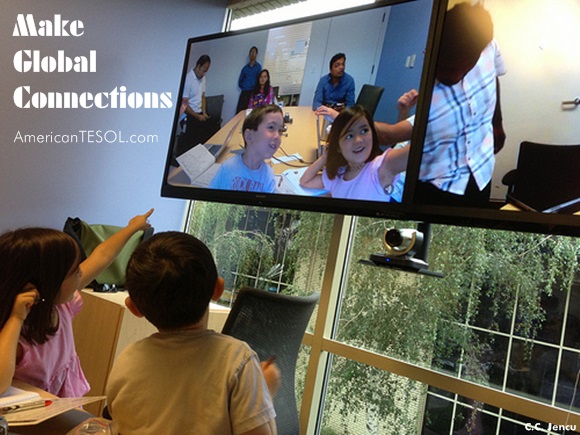Introducing young learners to global projects can be an inspiring way to enhance their English language skills while expanding their cultural awareness. Engaging students in collaborative projects with peers around the world not only fosters language development but also cultivates critical thinking, teamwork, and a sense of global citizenship. As TESOL teachers, incorporating global projects into the curriculum can transform the learning experience, making language acquisition more meaningful and relevant.
Why Global Projects?
Global projects connect students with diverse cultures, broadening their perspectives and allowing them to practice English in real-world contexts. The collaborative nature of these projects encourages communication, creativity, and problem-solving, providing learners with a platform to use English as a tool for sharing ideas and achieving common goals. Young learners can better grasp the importance of language when they see its use beyond the classroom, especially in understanding different cultures, traditions, and viewpoints.
Project Ideas for Young Learners
Here are some exciting global project ideas that can be integrated into English lessons for young learners:
- Cultural Exchange Projects: Partner with a classroom from a different country for a cultural exchange. Students can share aspects of their daily lives, festivals, traditional clothing, and cuisine through pictures, videos, or written descriptions. This not only improves their descriptive language skills but also helps them appreciate cultural diversity.
- Pen Pal Program: Establish a pen pal program with students in other countries. Writing letters or emails to international pen pals can be a great way for young learners to practice their writing skills, ask and answer questions, and learn about the world. It also introduces them to different writing formats and encourages authentic language use.
- Virtual Field Trips: Leverage technology to take students on virtual field trips to famous landmarks, museums, or natural wonders around the world. After the virtual visit, students can work in groups to create presentations or posters about what they learned, allowing them to practice speaking skills and expand their vocabulary.
- Global Storytelling: Have students collaborate with peers in different countries to create a shared story. Each classroom can contribute a chapter, adding their unique cultural touch. This project encourages reading and writing in English, promotes creativity, and results in a final product that students can share proudly.
- International Food Festival: Organize a classroom event where students learn about the cuisines of various countries. They can prepare simple dishes or bring recipes from their cultures to share. The event can be accompanied by descriptive writing tasks where students describe the ingredients, preparation process, and cultural significance of the dish.
- Environmental Projects: Join a global initiative focused on environmental awareness, such as recycling programs, tree planting, or reducing plastic use. Students can communicate with classrooms worldwide about local environmental challenges and solutions, improving their vocabulary around nature and sustainability while fostering a sense of global responsibility.
- Multicultural Music and Dance Exchange: Encourage students to learn about different traditional music and dances from around the world. Partner with other classrooms to share performances or music videos. This not only makes the language lessons more engaging but also exposes students to different rhythms, languages, and cultural expressions.
How to Implement Global Projects
To make global projects successful, here are some strategies for TESOL teachers:
- Start with Simple Projects: Begin with smaller, more manageable tasks, such as exchanging greeting videos or sharing photos of classroom activities. This helps establish a connection and allows students to get comfortable with the process.
- Use Technology Effectively: Tools like Zoom, Padlet, Flipgrid, and email make it easier to collaborate with international partners. Platforms that support file sharing and multimedia can enhance the project experience.
- Set Clear Goals and Expectations: Ensure students understand the purpose of the project, the tasks they need to complete, and the learning outcomes. This will help them stay motivated and focused.
- Provide Language Support: Offer students language resources and vocabulary lists related to the project. This will make it easier for them to express themselves and understand the material.
- Celebrate Achievements: At the end of the project, organize a celebration where students present their work to the class or parents. This can be in the form of an exhibition, video presentation, or a “global day” event.
Benefits of Global Projects
Global projects have numerous educational benefits. They:
- Enhance Language Skills: By communicating with peers from different countries, students practice reading, writing, listening, and speaking in authentic situations.
- Increase Cultural Awareness: Young learners gain an understanding of cultural diversity, which fosters open-mindedness and respect for different perspectives.
- Build Social and Emotional Skills: Working on global projects develops empathy, teamwork, and resilience as students navigate challenges and collaborate towards common goals.
- Encourage Curiosity and Lifelong Learning: Exposure to new topics and global issues stimulates curiosity, motivating students to continue learning about the world.
Fun Fact: A Global Project with a Big Impact
One well-known example of a global project that made a significant impact is the “Flat Stanley Project.” Started in 1995, this initiative involves sending a paper doll named “Flat Stanley” to different countries. Students document Stanley’s adventures through letters and photographs, creating a worldwide connection that helps young learners understand geography, cultures, and storytelling in a fun and engaging way.
Final Thoughts
Incorporating global projects into English language lessons allows TESOL teachers to create a dynamic learning environment that extends beyond textbooks and traditional activities. These projects provide young learners with the skills they need to communicate effectively in a globalized world, making language learning not just an academic pursuit but a tool for real-world connection and exploration. By encouraging students to participate in global projects, teachers are shaping not just proficient English speakers but also thoughtful global citizens.



